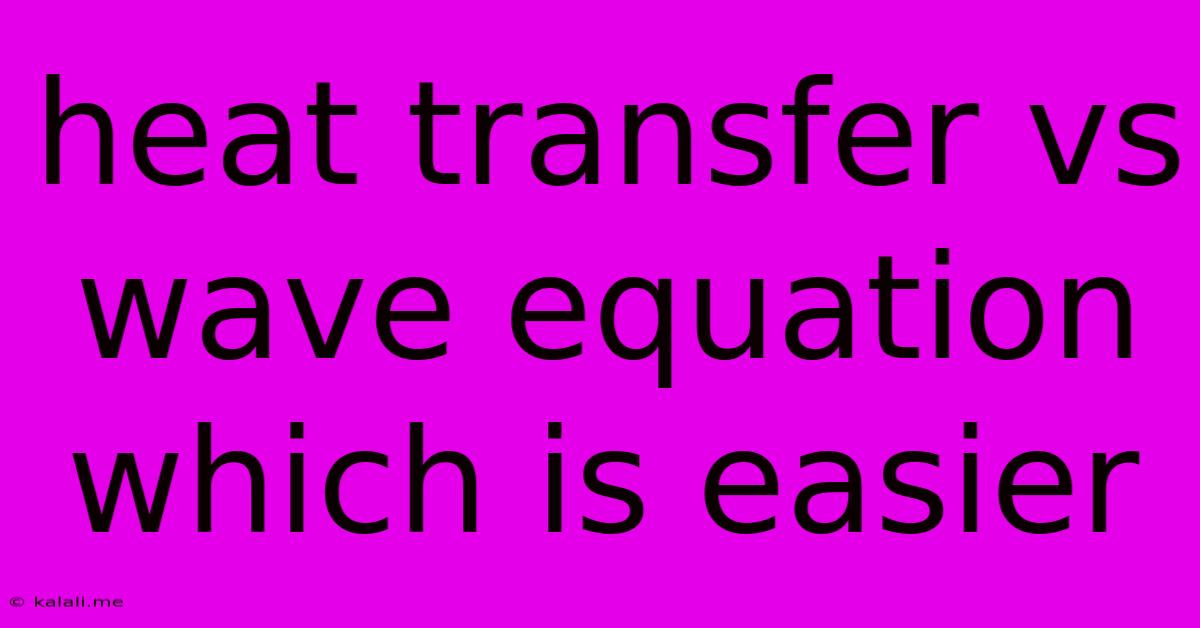Heat Transfer Vs Wave Equation Which Is Easier
Kalali
Jun 02, 2025 · 3 min read

Table of Contents
Heat Transfer vs. Wave Equation: Which is Easier? A Comparative Analysis
This article explores the relative difficulty of solving the heat equation and the wave equation, two fundamental partial differential equations (PDEs) in physics and engineering. We'll examine their similarities, differences, and the approaches used to solve them, ultimately offering insights into which equation is generally considered "easier" for beginners. Understanding these equations is crucial for anyone studying thermal dynamics, acoustics, or electromagnetism.
The heat equation describes the diffusion of heat within a material over time. The wave equation, on the other hand, models the propagation of waves, such as sound or light, through a medium. While seemingly distinct, both equations share underlying mathematical structures, yet their solutions and the methods used to obtain them can differ significantly.
Similarities Between the Heat and Wave Equations
Both the heat and wave equations are second-order partial differential equations, meaning they involve second-order derivatives with respect to both time and space. This shared characteristic leads to some similarities in their mathematical treatment, especially in the application of techniques like separation of variables. Both equations can also be solved using Fourier series and integral transforms, particularly for problems with specific boundary conditions.
Differences and the Source of Difficulty
The key differences lie in the nature of their solutions and the mathematical techniques best suited for solving them.
-
Nature of Solutions: The heat equation's solution represents a diffusive process. Heat spreads gradually and smoothly, tending towards equilibrium. The wave equation, however, describes propagative phenomena. Waves travel at a specific speed, retaining their shape (ideally) as they move through space. This fundamental difference influences the type of solutions we expect.
-
Mathematical Methods: While both equations can utilize separation of variables, the heat equation often benefits from techniques emphasizing decay and smoothing of solutions over time. This leads to simpler solutions in many cases, particularly for homogeneous boundary conditions. Conversely, wave equations often involve characteristic lines and the method of characteristics, which can be more complex for beginners. The superposition principle is also more straightforwardly applied to linear wave equations than to heat equations in many common scenarios.
-
Boundary and Initial Conditions: The types of boundary conditions significantly impact the complexity of the solution. Dirichlet, Neumann, and Robin boundary conditions are applicable to both, but the resulting mathematical complexities vary depending on the specific equation and the problem setup.
Which is Easier? A Matter of Perspective
For beginners, the heat equation is generally considered easier to grasp and solve than the wave equation. The reason lies primarily in the intuitive nature of heat diffusion. The concept of heat spreading smoothly is easier to visualize than the propagation of waves. The mathematical techniques commonly used to solve the heat equation, especially for simple geometries and boundary conditions, are often less technically demanding than those used for wave equations.
However, this "easier" assessment is relative. The difficulty of any PDE depends heavily on the specific problem's geometry, boundary conditions, and the desired level of accuracy in the solution. A simple heat equation with complex boundary conditions might prove more challenging than a relatively straightforward wave equation.
Conclusion
While both the heat equation and the wave equation are fundamental and important, the heat equation is often perceived as more accessible to beginners due to the intuitive nature of its physical interpretation and the generally simpler mathematical techniques used for its solution in common scenarios. However, both equations require a solid understanding of calculus, partial differential equations, and appropriate mathematical methods. The "easier" equation ultimately depends on the specifics of the problem at hand and the mathematical tools available to the solver.
Latest Posts
Latest Posts
-
Identify The Clause In The Sentence
Jun 03, 2025
-
Why Does My Cellular Data Keep Turning Off
Jun 03, 2025
-
How To Get Power Armor Training Fallout 3
Jun 03, 2025
-
Did Glenn Die In The Walking Dead Season 6
Jun 03, 2025
-
A Force Changes An Object Into Another Object
Jun 03, 2025
Related Post
Thank you for visiting our website which covers about Heat Transfer Vs Wave Equation Which Is Easier . We hope the information provided has been useful to you. Feel free to contact us if you have any questions or need further assistance. See you next time and don't miss to bookmark.